I’m Khushaly Bhatt
a
Technical Content Writer
Website Copy Writer
As a creative and versatile content writer, I craft compelling content that not only engages but helps businesses expand beyond expectations.
I have a keen eye for identifying key elements relevant to any subject and transforming them into shareable, impactful content. Every piece I write is tailored to enhance knowledge, engagement, and brand value—turning core ideas into dynamic narratives that inform, entertain, and drive results.
My expertise spans articles, blogs, product descriptions, guest posts, press releases, and website copy, ensuring diverse, high-quality content delivered on time, every time. Additionally, my understanding of SEO and audience-driven strategies helps my clients optimize their reach and maximize their business potential.
If you’re looking for captivating content that strengthens your online presence and converts customers, let’s discuss how I can help bring your ideas to life!
CONTENT WRITING SKILLSET
WHAT CAN YOU EXPECT FROM ME?

Blog Posts
Engaging and informal content helps you promote your brand while establishing credibility in your niche. Strengthen your connection with potential clients by refining your marketing strategy with well-researched and impactful content.

Article Writing
Provide your clients and newsletter subscribers with in-depth insights on key topics while boosting your website’s SEO rankings. Drive more targeted traffic, convert visitors into potential leads, and strengthen long-term relationships with your audience.

Product Descriptions
Highlight the unique value of your products to attract prospective buyers. Well-crafted descriptions help users understand the products better, increasing sales, revenue, and overall business success.

Infographics Content
Present complex data and graphical information in a concise, visually engaging format. Use creative analytics, images, videos, and graphs to highlight key statistics, making information both accessible and impactful.

Guest Posts
Share your expertise on external platforms, connect with industry thought leaders, and expand your brand’s credibility. Guest posting helps you reach a new audience while improving domain and page authority.

Press Releases
Announce the launch of a new product, service, or breaking news in a compelling way. Incorporate images, videos, and multimedia to boost engagement, improve news search engine visibility, and enhance public relations efforts.

Website Copies
Invest in professional, SEO-optimized website content to enhance visitor engagement and ensure a lasting impact. A well-crafted website creates a strong first impression, helping your business stand out and build credibility.

Case Studies
Showcase how your product or service has successfully gained market share by demonstrating real-world results. Provide insights into customer experiences, highlighting their responses and the impact of your solutions.

Brochure Content
Capture the interest of new customers and highlight upcoming events like exhibitions. A well-crafted brochure subtly conveys why your audience should be interested in your products or services, making the message engaging and approachable.
10+ YEARS OF EXPERIENCE
MY RESUME
Job Experience
Sr. Content Writer & Copy Editor
Current Employment (March 2023 – Present)A highly skilled and adaptable content writer, delivering engaging, SEO-optimized content across diverse industries. As a dedicated full-time freelancer, I bring creativity, precision, and a results-driven approach to every project.
Technical Content Writer, (Remote Employee - Full Time)
Silicon IT Hub Pvt Ltd. – Ahmedabad(April 2021 – Feb 2023) The Fourth Employment
I managed the development, refinement, and proofreading of content to align with diverse marketing objectives, ensuring impactful service promotion.
Content Writer, Editor, Copy Writer
(Jan 2019 – March 2021)I worked as a full-time freelance content writer based in Gujarat, India, creating a wide range of content, including blog posts, articles, product descriptions, and website copy to enhance product and service visibility.
Content Editor, R&D, Copy Writer
Joshi Biztech Solutions Ltd. – Bhavnagar(Jan 2018 – Dec 2018) The Third Employment
I conducted observational studies on finance and trading processes to deepen my understanding of blockchain technology for a writing project.
Sr. Content Writer, Editor, Copy Writer
AgileInfoways Pvt. Ltd. – Ahmedabad(Oct 2015 – Oct 2016) The Second Employment
I was responsible for creating original content for various business websites across industries such as IT, Health & Fitness, Travel & Hospitality, and E-commerce. I also wrote technical articles covering CMS & CRM platforms, web and mobile app development, IT trends, management strategies, and software solutions.
Jr. Content Writer, R&D, Social Media Writeups
iMOBDEV Technologies Pvt. Ltd. – Ahmedabad(Oct 2015 – Oct 2016) The First Employment
I was responsible for writing, editing, and proofreading in-house marketing materials for internal use, ensuring clarity and effectiveness. My role involved extensive research and consistent content creation.
Academic Credentials
MCA – Master of Computer Applications
Gujarat Technological University (GTU)
BCA – Bachelor of Computer Applications
DharmSinh Desai University (DDU)
HSC – Higher Secondary School Certificate
Gujarat Higher Secondary Education Board (GHSEB)
Content Writing Skills
Concept Adaptability
Topic Research
Linguistic Accuracy
Content Originality
Clarity and Focus
Time Management
Client Communication
Logical Flow
Documentation
Various Other Skills
Stay Current & Open to Change
Understand the Target Audience
Know the basics of Good SEO
Be Social Media Savvy
HTML / CSS
WordPress Blogging
Collaboration
Content marketing
Seek Feedback & Learn from Others
WHAT'S BEING SAID ABOUT MY WORK
TESTIMONIALS / FEEDBACKS

Billy Martin
Operating OfficerWeb App Development
via Facebook - Mar 2015 to Aug 2020She excels at researching and developing content while strategically incorporating SEO best practices to enhance visibility and engagement. Her professional attention to detail ensures accuracy and relevance, resulting in unique, high-quality content tailored to our needs. Her dedication to delivering well-optimized and polished work has been invaluable. Thank you!

Milind Sanghvi
Marketing PersonnelWebsite Pages Content
via Facebook - Mar 2015 to Aug 2020Despite the tight deadline, she put in immense effort to ensure every page was completed on time with precision and quality. Her dedication and hard work have resulted in content that will not only meet but exceed our client’s expectations. The value she has added to this project is truly appreciated. Thank you!

Ritika Tikoo
Chief Content ManagerTechnical Content, Blogs and Articles
via Social Platforms - Feb 2025 to May 2025She grasped the core concept effortlessly and expressed it using strategically placed keywords to enhance clarity and effectiveness. By blending originality with relevance, she created well-optimized, keyword-rich content that was both engaging and informative. Her meticulous attention to detail ensured accuracy, and her commitment to timely delivery made the process smooth and efficient.

Shishir Odedra
Tech LeadTravel Mobile App Design.
via Upwork Platform - Mar 2019 to Aug 2021Hello Khushaly, I just wanted to take a moment to say thank you for all the support you’ve provided with content creation. The quality of your work has truly exceeded my expectations, and it has made a significant impact on my newly launched website. I’m optimistic about the results this content will bring and look forward to seeing its positive effect. Your efforts have been incredibly valuable, and I sincerely appreciate your time and expertise. Many thanks again!
CONTENT WRITING PORTFOLIO
MY RECENT BLOGS / ARTICLES
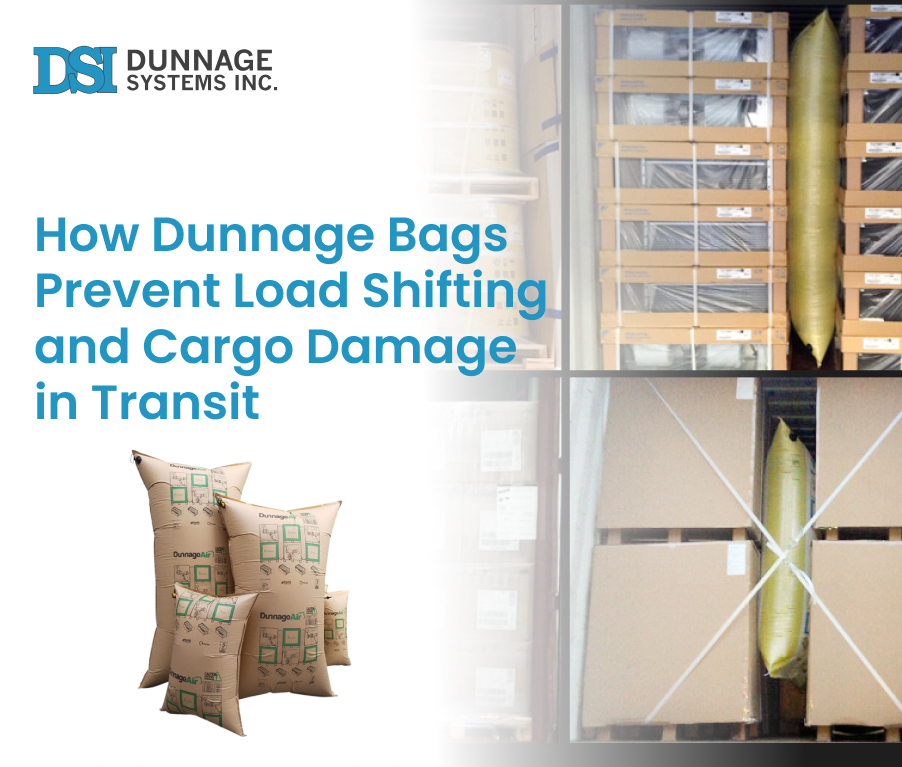
How Dunnage Bags Prevent Load Shifting and Cargo Damage in Transit
Cargo damage during transportation costs money. It decreases the speed of deliveries and creates waste that irritates customers. Generally, it happens because things move around during shipping. A bumpy road and a sharp turn can move the load and break what is inside. That is when dunnage bags come in.
These bags are inflatable cushions placed between boxes and pallets to fill empty spaces and keep cargo safe from any movement. Whether you are shipping by truck, train, or sea, shipping dunnage keeps everything in place.
Cargo airbags are simple and affordable to use. They do not need any fancy equipment. Just inflate, pace, and secure. And they work.
This blog walks through how dunnage bags stop cargo from shifting and reduce damage to deliver the shipment safely. If you are transporting anything fragile or heavy, this matters.
What Are Dunnage Bags?
Dunnage bags are inflatable cushions which is used to keep cargo from moving during the transportation process. They are placed in the empty spaces between boxes or pallets. Once inflated, they keep cargo from moving and help prevent damage.
Also read our blog on, Which Industries Use Dunnage Bags for Cargo Safety?
What Is the Purpose of a Dunnage Bag?
The purpose is very simple: To stop cargo from any movement during shipping.
When goods move around, they can break or tip over. A shipping airbag helps prevent that. It adds pressure between items so they stay where they should. No matter which mode you choose for shipping, inflatable dunnage bags ensure your cargo remains as it is.
Types of Dunnage Bags
There are a few kinds of industrial dunnage bags depending on what you are shipping.
- Paper Dunnage Bags: It is made from kraft paper and a plastic inner lining. These are good for lighter loads and are generally used in consumer goods or food transportation.
- Polywoven Dunnage Bags: It is made from woven polypropylene (Plastic). These are strong and reusable. These are good for heavy cargo like machinery or bulk goods.
Each type of shipping air bag is built to perform a particular job. When you select the right one, it protects your goods and avoids damage.
Please read our detailed guide on The Ultimate Guide to Dunnage Bags: Types, Uses, and Benefits.
Dunnage in Trucking and Container Shipping
What is dunnage in trucking?
In trucking, dunnage refers to materials used to keep cargo stable inside trailers and prevent items from sliding or tipping. This includes
-
- Wood blocks
- Foam pads
- Shipping airbags
Drivers use them in flatbeds and dry vans, where sudden stops or sharp turns can move the load. Dunnage avoids damage and keeps the truck balanced.
Container dunnage
In container shipping, dunnage performs the same job, but the environmental conditions are different. Containers travel long distances and face
- Constant movement
- Stacking pressure
- Temperature changes
That is why airbag shipping is common here. Inflatable dunnage bags go between pallets or boxes to hold the load and absorb shock.
Purpose and Benefits of Using Dunnage
What is the purpose of using dunnage when securing cargo?
Dunnage keeps cargo stable by
- Filling the gaps
- Adding pressure
- Stopping items from sliding/tipping
Whether it is wood blocks or cargo air bags, the goal is the same: to keep things as they are during the entire shipping process.
What is dunnage primarily used to protect cargo from?
Dunnage protects cargo from damage caused by
- Movement
- Shock
- Moisture
It acts like a buffer. Without it, goods can
- Shift
- Bump into each other
- Get crushed
Why is it important to use dunnage when moving loads?
There are high chances that loads that move can break and cause accidents or delays during transportation. Using shipping dunnage makes transport secure and more reliable. It helps to follow safety rules and decrease the chance of returns or claims.
Benefits of Using Dunnage
- Cargo moves during transit. Dunnage stops that.
- Goods get damaged from bumps. Dunnage cushions them.
- Loads can tip or slide. Dunnage holds them in place.
- Some dunnage materials block water or dirt from reaching the cargo.
- Fewer damaged items mean fewer complaints and lower costs.
How Dunnage Bags Work

Inflatable dunnage bags are simple tools, but it is important to use them the right way for better results. Here is how they work:
Inflation Process
You inflate the bag using a pump or air compressor.
- Attach the nozzle to the valve.
- Fill the bag until it is firm.
- Do not overinflate, it can burst.
- Do not underinflate, it will not hold the load.
Most industrial dunnage bags have pressure limits. Check the label. Light-duty bags usually go up to 2 PSI. Heavy-duty ones can handle more.
Placement Techniques
Where you place the bag matters.
- Put it between cargo, not under or on top.
- Center it in the gap so it touches both sides.
- Place it at mid-height, not too low or high.
Good placement helps the bag do its job. Bad placement can lead to damage.
Pressure Ratings
Each bag type has a limit.
Most bags can handle between 2 and 10 PSI. The exact limit depends on the strength of the bag and what is in the bag. Paper and poly bags follow the same general range. What matters more is the bag’s grade and how it is meant to be used – not just the material.
Match the bag to the cargo weight and transport type. Do not guess.
Preventing Cargo Loss and Damage
What will you do to prevent cargo loss or damage?
Use the right tools. Secure the load.
- Use proper packaging
- Fill empty spaces
- Brace cargo with tools like shipping airbags
These inflatable dunnage bags keep goods in place and absorb shock during the entire shipping process. They are simple to use and make a big difference.
ROI and Cost Savings
Using shipping airbags saves money.
- Less damage means fewer replacements.
- Fewer claims can lower insurance costs.
- Reusable bags cut down on waste.
- Stable loads are faster to handle, which saves time.
Most companies see fewer returns and fewer delays. That adds up.
Choosing the Right Dunnage Bag
Not all bags are the same. Picking the right one is not complicated. You just need to match the bag to the job.
What to Look At
| Cargo Type
Heavy loads need strong support. Fragile items need soft cushioning. Know what you are shipping. |
Transport Mode
Truck: Use bags that handle quick stops and sharp turns. Rail: Go with tough industrial dunnage bags that absorb shock. Sea: Choose moisture-resistant bags for long trips and a stacked container. |
| Bag Material
Paper: Good for light loads. Polywoven: Strong and reusable. |
Size and Fit
Measure the gap between items. The bag should be slightly wider than the space when inflated. Too small bags will not hold goods. Too big bags might burst. |
Tips for Sourcing Quality Products
- Check pressure ratings
- Look for certified suppliers
- Match the bag to the weight
- Ask if the bag is reusable
- Test a few before buying in bulk
Container dunnage works best when it is chosen with care. The right bag keeps cargo safe and saves money in the long run.
That’s a Wrap
Dunnage bags do one thing well: they keep cargo from moving.
That means
- Fewer broken items
- Fewer delays
- Fewer complaints
If you are using paper bags for light loads or industrial dunnage bags for heavy shipments, the goal is the same: protect what you are shipping.
Want to see how it works for your business?
Explore Dunnage Systems Inc. or request a product demo. It is a simple step that can save time and money.
Source: https://dunnagesystems.com/how-dunnage-bags-prevent-load-shifting-and-cargo-damage-in-transit/

How a Fractional CMO Helps Align Sales and Marketing for Scalable Growth in 2025
In some companies, sales and marketing don’t work as a team: They aim for the same goals, but often speak different languages. This disconnect leads to mixed messages and lost opportunities. A Fractional Chief Marketing Officer can help solve this by aligning both sides under a shared strategy, increasing efficiency, and reducing the time to a closed deal without adding a full-time executive to the payroll.
According to HubSpot, 44.8% of marketers and 40.4% of sales professionals reported that alignment between sales and marketing became more important in 2022, yet miscommunication and separate funnels still hinder performance. Gartner adds that 47% of misalignment stems from disconnected lead funnels, directly impacting conversion rates and sales cycle time.
Remote work and hybrid setups have made this gap even wider. Teams are spread out and siloed. Without a well-defined plan, tasks often fall through the cracks. This is where a Fractional CMO comes in. This part-time marketing leader helps connect the dots. They bring focus, structure, and strategy, without the cost of a full-time hire.
More small and mid-sized companies are choosing fractional CMO services. They see it as a flexible way to get expert marketing help to connect sales with marketing.
What Is a Fractional CMO, and What Do They Do?
What Is a Fractional CMO?
A Fractional CMO is a part-time marketing leader. Hiring a Fractional CMO helps companies build strategy, guide teams, and improve results, all without hiring a full-time executive.
Fractional CMOs are not just consultants; they work within the business, leading teams and projects. They work to refine messaging that resonates with your target audience, ensuring that the marketing supports the sales team.
How They Compare
| Role | Time Commitment | Strategic Ownership | Team Leadership | Cost |
|---|---|---|---|---|
| Full-Time CMO | Full-time | Yes | Yes | High |
| Consultant | Project-based | Limited | No | Medium |
| Fractional CMO | Part-time | Yes | Yes | Flexible |
A full-time Fractional Chief Marketing Officer is great for large and small companies. Consultants help with short-term advice, but a part-time CMO offers leadership and flexibility. That’s why more startups and mid-sized firms are choosing this model, whether they’re B2B or B2C.
What Do They Actually Do?
- Cross-Functional Team Leadership: Leadership is an important part of the role. A part-time CMO works with internal teams and outside partners. They work closely with sales and product teams and coordinate with leadership to keep goals aligned.
- Strategic Planning Across Sales Funnels: A part-time CMO helps connect marketing with sales. They look at the full funnel, fix broken handoffs, and build systems that consistently bring in leads.
- Brand Positioning and Messaging: A fractional CMO shapes how a brand is seen by refining the value proposition and keeping messaging clear. They also help to build go-to-market strategies that reach the right audience.
- Data-Driven Decision-Making: They use data to make decisions. They set goals and track progress. They also adjust budgets based on what’s working. They don’t guess, they measure.
The part-time CMO focuses on marketing strategy, execution, and business alignment. They make sure marketing gets results.
Here’s a simple table that compares a Fractional CMO vs. a Traditional CMO side by side.
| Category | Fractional CMOs | Traditional CMOs |
|---|---|---|
| Time Commitment | Works part-time or on specific projects | Works full-time in a permanent role |
| Cost | Costs less each month (around $5K–$15K) | Costs more each year with salary and benefits (around $200K–$400K) |
| Team Leadership | Leads internal/external teams as needed | Leads the company’s internal marketing team |
| Strategic Ownership | Handles big-picture planning and keeps teams aligned | Oversees strategy and daily execution |
| Flexibility | Works across multiple clients; scalable | Dedicated to one company; fixed scope |
| Best Fit For | Small to mid-sized growing companies that need flexible leadership and proven expertise | Enterprise companies with steady budgets and long-term plans |
| Hiring Speed | Quick onboarding, minimal overhead | Longer recruitment and integration process |
| Engagement Model | Works on contract, retainer, or as an advisor | Hired full-time with a long-term role |
| Risk Profile | Lower financial and operational risk | Higher investment and long-term dependency |
| Business Alignment | Helps connect marketing with sales and product teams | Works closely with all departments to stay aligned |
How a Fractional CMO Aligns Sales and Marketing
1. Building Unified Buyer Personas
A fractional CMO works with both sales and marketing to build shared buyer profiles. Instead of each team chasing different types of leads, they create one clear view of the ideal customer. They map the full customer journey, define what qualifies a lead, and sync everything with CRM systems. This keeps both teams aligned and accountable by measuring agreed-upon KPIs and focusing on the same goals.
2. Streamlining Messaging Across Touchpoints
They keep the brand voice consistent from start to finish. The messaging stays clear whether it is B2B or B2C. People trust your brand when it’s easy to recognize and stays consistent across all the channels.
3. Data-Driven Collaboration
A part-time CMO sets common goals and creates reports and dashboards for both sales and marketing to use. They track where leads come from and measure return on investment. They also make sure both teams are using the same data to stay aligned. When both teams use the same metrics, decisions are clearer and results are easier to track.
Teams with aligned sales and marketing see up to a 36% increase in conversion rates, according to WinSavvy’s 2024 alignment statistics.
Compared to a traditional CMO, a fractional CMO offers flexible leadership and quick integration. You get senior-level support without the cost or commitment of a full-time hire.
If your teams need alignment but you’re not ready to expand your payroll, hiring a fractional CMO might be the right move.
Benefits of Hiring a Fractional CMO
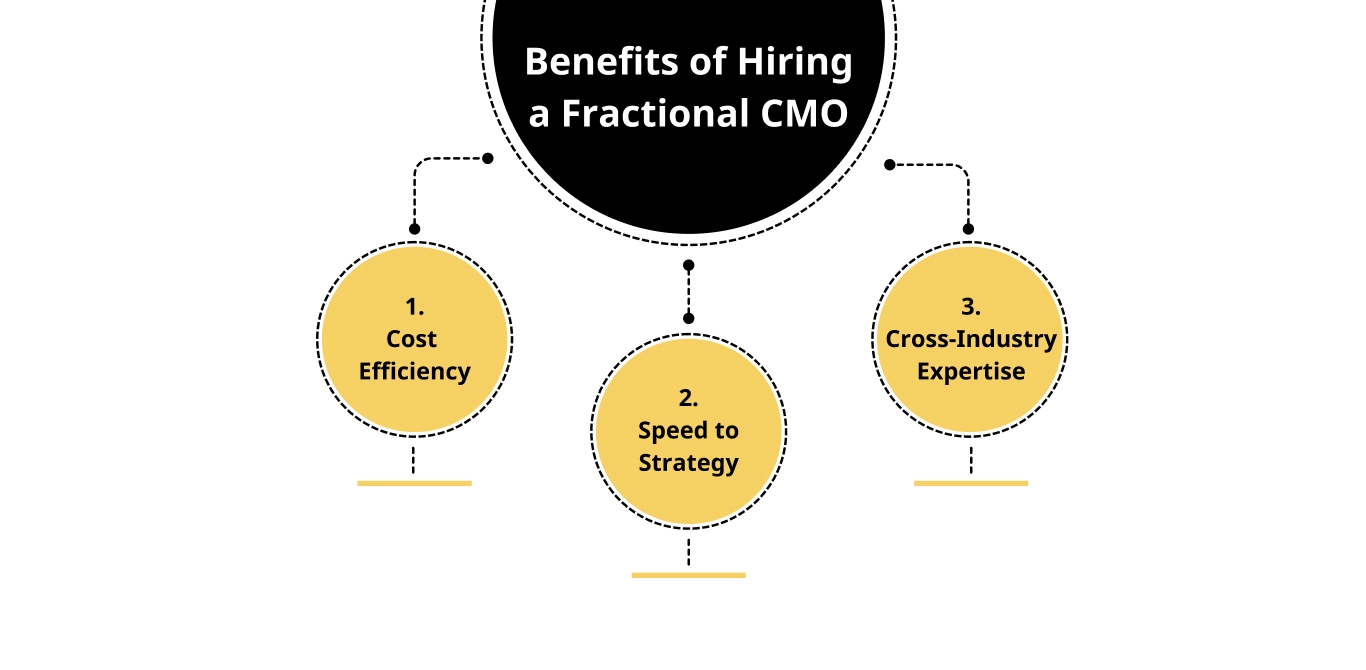
1. Cost Efficiency
A fractional CMO is a smart choice for companies that need expert help without paying for a full-time executive – no salaries and bonuses, no health insurance bills, no long-term contracts tying you down. Instead, you leverage the expertise for what you need, whether it’s a single campaign or ongoing monthly support. It’s perfect for teams that are scaling.
2. Speed to Strategy
A fractional CMO can step in quickly, assess your current strategy, and start making changes without internal delays. They help teams focus and simplify what matters most, making sure the work gets done.
3. Cross-Industry Expertise
A fractional CMO brings experience from other industries. This knowledge enables them to adapt messaging and strategy to fit different industry sectors and markets. In addition, this enables them to make experience-based decisions that avoid pitfalls and shorten the path to success.
When to Choose a Fractional CMO Over a Traditional One
Many times, a company can’t afford or doesn’t need a full-time marketing leader. Often, a fractional CMO is a better fit.
Ideal Scenarios
Your startup’s growing fast, and you need someone to lead strategy and structure. But you don’t need a full-time salary weighing you down. That’s where a fractional CMO comes in: experienced marketing leadership without the extra cost.
If you’re running a mid-sized company with a small team, you likely have people who know how to get things done. However, you also need someone who can develop a vision, lead, clarify the message, and keep everything on track. Additionally, a fractional CMO can identify gaps in personnel and help recruit suitably qualified new hires.
Decision Framework
Before you decide, consider:
- Do you need a smart strategy but not a full-time hire?
- Are sales and marketing working in silos?
- Is a new product or service launch coming up with no one to lead it?
- Do you want results without a long-term contract?
If that sounds familiar, fractional CMO services are worth considering.
Conclusion: When Expertise Meets Flexibility
If your team needs direction but not another full-time executive, it is time to hire a fractional CMO. Whether you’re scaling quickly or launching something new, or just trying to get sales and marketing on the same page, a fractional chief marketing officer gives you senior-level support without the long-term contract.
The Field Group has expertise in fractional CMO services for startups and small businesses. Our team helps sharpen your brand, drive revenue, and keep things focused, especially when you’re in the middle of change and striving to grow. We have worked across tech, media, and consumer goods, so we know how to step in and get results.
Ready to align your teams and grow your revenue? Explore how fractional CMO services can bring clarity and results to your business.
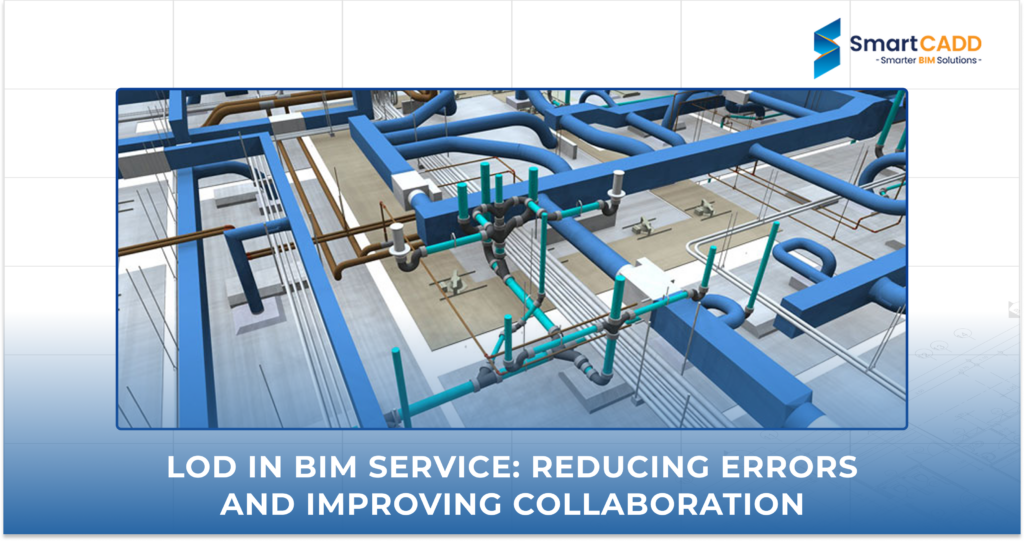
LOD in BIM Service: Reducing Errors and Improving Collaboration
In construction, small mistakes can lead to big problems. That’s why BIM Services rely on clear and accurate models. One way to make sure everyone is on the same page is through LOD (Level of Development) BIM.
If you are wondering what LOD is in construction, it is a way to show how detailed and reliable each part of the model is. When teams know what to expect from the model, they make fewer errors and work together more easily. It is a simple idea that avoids confusion and keeps projects on track.
In this article, we will explore how LOD BIM improves BIM services by:
- Fewer mistakes during design and construction
- Better teamwork across different roles
- Easy decisions at every stage of the project
Whether you are a BIM professional or just getting started with digital construction, LOD helps you with smart and more efficient project execution.
What Is LOD in Construction and BIM?
LOD means Level of Development. It is used in construction and BIM to show all the details included in a model. When the LOD is higher, it delivers more accurate and reliable information.
If you are asking what LOD is in construction, think of it as a scale. At the start, you will have rough shapes and general concepts, which are enough to visualize the idea (LOD 100). As the project design progresses and moves forward, more information is added till the time it is ready to build from (LOD 400) or shows the final built result (LOD 500).
Teams know what they are looking at with each BIM level of detail. It avoids confusion. It makes coordination easy and helps people make better decisions.
Here is why the level of detail in BIM matters:
- It sets clear expectations.
- It improves communication between teams.
- It decreases errors and rework.
Breakdown of LOD Levels in BIM Services
| LOD Level | Name | Description | Use Case |
| LOD 100 in BIM | Conceptual Design | Basic shapes and symbols representing overall massing and location | Feasibility studies,
early design intent |
| LOD 200 in BIM | Approximate Geometry | Generic geometry with estimated quantities, size, shape, and location | Schematic design, spatial coordination |
| LOD 300 in BIM | Precise Geometry | Accurate geometry, dimensions, and placement suitable for coordination | Construction documentation, clash detection |
| LOD 350 in BIM | Detailed Connections | Includes interfaces between building systems and constructability details | Advanced coordination, constructability review |
| LOD 400 in BIM | Fabrication and Assembly | Model includes fabrication details, assemblies, and installation specifications | Prefabrication, construction execution |
| LOD 500 in BIM | As-Built / Facility Management | Reflects actual installed components and conditions for operations | Facility management, maintenance |
When you use the correct BIM LOD level at each stage, keep the model balanced. It ensures that models are not too detailed or too unclear and helps to save time and rework.
How LOD Modeling Reduces Errors
LOD modeling helps teams avoid mistakes before they happen. It is part of how BIM services keep projects on track.

Here is what it does:
- It catches clashes early
With accurate geometry and system interfaces (LOD 300 and above), it is easy to identify problems, like pipes running through walls or beams blocking ducts. That means fewer issues during construction. - Clear communication among stakeholders
Each BIM level of detail sets expectations. Clear models help architects and contractors understand what is expected. No guesswork. No confusion. - It cuts down on rework and RFIs
When models are clear and complete, teams do not need to keep asking for missing information. That saves time and avoids delays.
LOD modeling is not about adding more. It is about adding what is needed so the work gets done right the first time.
Improving Collaboration Through BIM LOD Levels

Working on a building project means managing input from different teams. Everyone has their priorities. Without a shared system, everything creates confusion. That is where LOD BIM helps. By setting clear expectations for what each model includes, BIM LOD levels help each team stay aligned without any guesswork and surprises.
What LOD Does
BIM LOD levels show how much detail a model should have at each stage. Architects focus on form and space. Engineers care about systems and structure. Contractors need buildable details. It is a way to set clear expectations without any guesswork.
- LOD 100–200: Good for early design. Shapes and spaces are rough.
- LOD 300: More detail. You can start coordinating between teams.
- LOD 350: Adds connection points. Helps spot clashes before construction.
BIM LOD Real Example: LOD 350 for MEP
On a recent project, a performing arts center in California used LOD 350 for MEP modeling and coordination. The team modeled,
- HVAC
- Plumbing
- Electrical systems
They included,
- Hangers
- Brackets
- Other connection details
This helped them catch problems early—like pipes running into ducts—before anything was built.
By using LOD BIM at the right level, the project team:
- Identified and resolved system clashes early
- Shared updated plans with all stakeholders
- Improved installation accuracy and safety
Why It Matters
When everyone works from the same level of detail, things go faster. Fewer surprises. Fewer delays. BIM Services that use the right LOD level help teams stay on track.
Best Practices for Implementing LOD in BIM Projects
Getting the right level of detail in BIM matters. It helps teams avoid confusion and work more efficiently. Here is how to make LOD modeling work better in real projects:
- Define LOD Requirements Early: Decide what detail is needed at each stage. Do not wait. Clear LOD goals help everyone know what to build and when.
- Include LOD in Contracts: Make it part of the agreement. If the model needs to be at LOD 300, say it clearly. This avoids confusion later.
- Use BIM Tools to Stay Consistent: Most BIM Services include tools to manage LOD. Use them to track progress and make sure the model matches the plan.
That’s it. No fluff. Just a few simple steps to keep your BIM project on track
Closing Notes
LOD brings order to BIM projects. It tells teams what and when to model, and how much detail is needed. That means fewer mistakes and better teamwork.
SmartCADD uses LOD to keep BIM projects clear and consistent. Their team knows how to apply the right detail at the right time—so models stay useful, not overloaded.
If you want BIM services that are practical, well-structured, and built around your project goals, talk to SmartCADD. We will help you set clear standards and deliver work that fits.
Source: https://www.smartcadd.com/lod-in-bim-service-reducing-errors-and-improving-collaboration/

How Digital Twins Empower Real‑Time BIM Asset Management
The world of BIM asset management is growing rapidly. It is expanding beyond static 3D models to benefit from dynamic and data-driven systems that reflect real-world conditions in real-time. At the base of this change is the BIM digital twin. It is a virtual replica of a physical asset with live data streams. They connect the design, construction, and operations phases of the project, helping teams monitor, analyze, and improve assets more effectively.
In this blog, we will explore how digital twins are changing real-time BIM asset management to enable expert decisions and proactive maintenance during the asset lifecycle.
What Is a Digital Twin in the Context of BIM?
Definition of a digital twin: A digital twin is a virtual copy of a physical asset that uses real-time data from different sources, like sensors and IoT devices. A digital twin keeps updating to reflect the current condition and performance of the asset.
Many people ask, “Is BIM a digital twin?” The answer is NO, but they work best together.
Building Information Modeling (BIM) provides a detailed structure design and construction model. On the other hand, digital twin frameworks change the model into a live representation during the building operations phase.
To put BIM vs digital twin briefly, BIM is a blueprint of a building, and the digital twin is a constantly updating version that shows building performance in real-time. Together, they connect design plans with real-world operations. It helps teams with improved decision-making and proactive asset management.
How Digital Twins Enhance BIM Asset Management
When powered by AI (Artificial Intelligence), types of digital twins offer innovative visibility and control on the asset lifecycle.
- Real-time data integration from IoT sensors: By updating the data continuously from the linked IoT devices, a digital twin AI model reflects the current condition of the infrastructure or a building. This helps facility managers to
- Monitor performance
- Detect irregularities
- Respond proactively
- Predictive maintenance and lifecycle optimization: With the help of historical and real-time data, digital twins predict potential failures before they take place. This predictive capability offers some key advantages in BIM asset management, such as,
- Decreased downtime
- Extended asset lifespan
- Simplified maintenance schedules
- AI-powered insights for operational efficiency: With digital twin AI, stakeholders and facility managers can have actionable insights into the usage of energy and space, as well as monitor system performance. These analytics help with
- Smarter decision-making
- Decreased operational costs
- Support sustainability goals
By integrating digital twins and AI, businesses can have a smart and more responsive approach to managing construction cycles. It makes BIM asset management more intelligent than ever before.
Applications of 3D Digital Twins in Infrastructure
Let’s explore some digital twin examples across industries.

1. Smart Buildings
3D digital twin technology makes building more efficient and smart. It generates a virtual copy of a building that shows how different systems (like heating, cooling (HVAC), lighting, and room usage) are working in real time.
- Building managers can see everything taking place inside the building from one dashboard.
- There is no need to be available on-site to change the temperature, lighting, and other settings.
- The system saves energy by switching off lights or adjusting HVAC when there is no one in the rooms.
- It also improves comfort for people inside by keeping conditions right.
2. Transportation Networks
Using a 3D digital twin, cities and transportation systems run smoothly by creating a virtual model of transportation infrastructure (i.e., Railways, Roads, Traffic signals, and so on).
- Operators can monitor trains, buses, and cars in real-time.
- They can identify issues early and solve them quickly.
- Teams can try out different traffic plans to identify the fastest route.
- Teams can respond quickly in emergency situations like accidents or delays.
3. Utilities Management
These 3D models make it easy to manage important services like water, electricity, waste, and so on with real-time sensor data and live models.
- From a central location, companies can monitor
- Pipelines
- Power lines
- Waste systems
- To avoid service interruptions, sensors help with the early detection of
- Leaks
- Equipment failures
- Unusual activity
- These 3D virtual models can forecast the amount of water or energy people will need. Based on that, the supply can be adjusted earlier.
- They also support long-term planning by showing how systems will perform under different conditions, like population growth or environmental change.
Building a Digital Twin Framework for BIM
Creating a robust digital twin framework for BIM includes the connection of physical assets with smart and data-driven systems.
Key Components of a Digital Twin Framework
- Data Sources
- The framework includes
- BIM digital twin software
- Sensor data
- GIS (Geographic Information Systems)
They all work together into a single digital system.
- IoT Integration and Cloud Platforms
IoT devices collect real-time data from buildings and infrastructure. Cloud platforms store and process this data for easy access and collaboration. - Integration Strategies
A good framework connects with existing systems by using- APIs
- Middleware
- Standardized data formats
It helps digital and physical assets share information easily.
Common Challenges and Solutions
| Challenge | Solution |
| Data is spread, and systems do not work well together | Use open standards and a centralized place for all data |
| Setup is costly and complicated technically | Start with small test projects and grow step by step |
| Security and data privacy issues | Use strong encryption and limit data access |
With the digital twin framework, businesses can benefit in the matter of BIM. It turns fixed models into smart and interactive tools for better asset management.
Future of BIM Asset Management with AI and Digital Twins
The future of BIM asset management is being shaped by powerful technologies like
- Automation
- Digital twin AI
- Scalable data systems
These technologies are changing how authorities manage and improve buildings and infrastructure.
Emerging Trends to Watch

- AI and Machine Learning for Predictive Analytics
To decrease downtime and improve productivity, smart algorithms use real-time data and predict- Equipment failures
- Energy usage
- Maintenance requirements
- Automation in Facility Operations
From controlling environmental changes to lighting systems, AI digital twins automate adjustments according to- Occupancy
- Usage patterns
- Environmental conditions
- Scalability for Smart Cities and Sustainable Infrastructure
As urban areas grow, digital twin AI allows BIM systems to scale across multiple assets, supporting- Smarter planning
- Resource management
- Sustainability goals
Businesses can create smart and eco-friendly infrastructure by combining BIM Asset Management with AI-driven digital twins.
Conclusion
Digital twin frameworks are transforming the world of BIM asset management by replicating everything in real-time. From tracking performance, spotting issues early, and supporting critical decision-making, digital twins are the next step forward in managing infrastructure.
At SmartCADD, we believe digital twins offer a powerful way to stay ahead in a fast-changing world—helping to reduce costs, minimize downtime, and maximize operational efficiency.
Start exploring digital twins with SmartCADD to build stronger, smarter, and more efficient systems.
Source: https://www.smartcadd.com/how-digital-twins-empower-bim-asset-management/

Custom FIBC Bags: Why Tailoring Your Packaging Matters
Packaging today is not only about the safety of your products; it is much more than how your products move and are stored securely for reliable delivery. Custom FIBC bulk bags are the best choice for businesses looking for smart and secure handling of heavy materials.
Customization of these bulk bags to address specific operational needs makes the shipping process easy, as well as increases brand reliability.
In this blog, we will learn why customization is important and how it helps to improve your packaging strategy.
So let’s get started without any further ado!
What are FIBC Bulk Bags?
FIBC bulk bags are large bags that offer durability when you want to transport and store bulk materials easily. Many industries are using these bulk bags made with woven polypropylene to manage their large quantities of flowable and dry goods.
Please check out the detailed guide on What Are FIBC Bulk Bags? Types and Benefits
These bags are reliable solutions to decrease packaging waste and storage space requirements. They have a strong structure but are light in weight, which increases safety while transportation with different capacities. It manages bulk material with different designs, such as,
- Standard
- Food-grade
- Conductive
Standard Types of FIBC Bulk Bags
By Electrostatic Classification:
| Type | Description | Safe For | Not Safe For |
| Type A | No static protection | Non-flammable materials | Flammable environments |
| Type B | Low breakdown voltage | Dry flammable powders | Flammable gases or solvents |
| Type C | Conductive fabric with grounding | Flammable powders, vapors | If grounding is not ensured |
| Type D | Antistatic fabric, no grounding needed | Combustible environments | If the surface is contaminated |
By Construction Style:
- U-Panel Bags: Strong support for heavy loads
- 4-Panel Bags: Ideal for stacking and stability
- Circular Bags: Seamless sides for fine powders
- Baffle Bags: Maintain shape and maximize space
Why Customization of FIBC Bulk Bags Matters in Packaging?
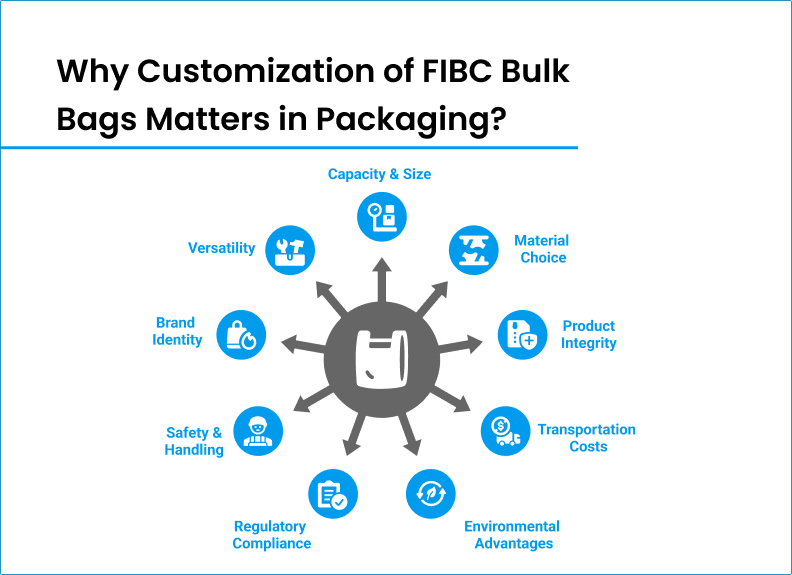
In bulk packaging, one size does not fit all. Customization of FIBC bulk bags ensures ease of operations and product safety with regulatory compliance across industries. Here’s why tailoring your packaging is important:
Importance of Customizing Capacity, Size, and Material
Precision is important, like matching bag specs to your product’s weight, volume, and sensitivity, which helps to avoid costly errors.
- Align bag dimensions with exact load requirements, as it prevents you from the risks of underfill or overfill.
- Select materials which are which are perfect for your product sensitivity, like
- Moisture
- Chemical reactivity
- Static discharge
- You need to make sure that the bags work smoothly with your equipment and storage setup.
Impact on Product Integrity and Transportation Costs
You can protect your goods and margins with smart packaging.
- When you choose fit-for-purpose designs, it can decrease
- Damages
- Spillage
- Contamination
- Improve container and truck space with bags that are accurate with dimensions.
- Reduce shipping costs with lightweight bags that stack easily and use less space.
Environmental and Regulatory Advantages
When you choose smart packaging, you can contribute to protecting the planet and meet regulations.
- Choose eco-friendly liners that are recyclable or biodegradable, as they address sustainability standards and decrease the impact on the environment.
- Follow UN and food-grade standards that ensure safe and certified packaging for sensitive materials or bulk goods.
- Support corporate sustainability by choosing reuse-ready bulk bags that
- Reduce waste
- Promote efficiency
- Align with eco-driven business goals
Improved Safety and Handling
Customized features improve workflow and decrease the chances of risks.
- To increase the speed of warehouse operations and improve handling precision, use
- Custom loops
- Spouts
- Pallet-friendly designs
- While loading and unloading your products, add ergonomic features that
- Ease lifting
- Reduce fatigue
- Decrease mistakes
- Choose FIBC bags with materials that protect against
- Static
- Moisture
- Harsh exposure
Brand & Operational Identity
Your packaging quietly represents your brand wherever your product goes.
- Add printed codes and symbols that improve
- Product tracking
- Safety info
- Visual recognition
- Add barcodes/QR codes for inventory management and link products to digital systems and real-time monitoring.
- Add branded visuals on packaging that
- Increase visibility
- Strengthen identity
- Enhance recognition
Versatility for Multi-Purpose Use
One bag is used in many ways across industries, products, and logistics.
- Create different bag designs that work for various product categories and businesses that decrease inventory complexity and improve productivity.
- Customize bag specifications to handle
- Seasonal changes
- Regional demands
- Export logistics
- Use flexible bags that meet different industry standards and allow one type to serve
- Food
- Pharma
- Agriculture sector
Key Customization Options for Bulk Bags
Customizing FIBC bulk bags ensures they address the particular needs (Operational, Safety, Branding, etc.) of industries.
| Category | Feature | Description |
| Functional Features | Liners | Form-fit, baffled, or foil liners for moisture, chemical, and oxygen protection |
| Best choice for food-grade, pharmaceutical, and chemical applications | ||
| Discharge Spouts | Options: plain bottom, conical spout, duffle bottom, iris closure | |
| Help with controlled and clean emptying of contents | ||
| Lifting Loops | Designs: cross-corner, side-seam, stevedore straps, single/two-loop | |
| Improves compatibility with forklifts and cranes | ||
| Protective Enhancements | UV Protection | Fabric stabilizers to avoid degradation from sunlight exposure |
| Important for outdoor storage and transport | ||
| Moisture Barriers | Coated fabrics or liners to stop humidity and water vapor | |
| Help save product integrity during transit | ||
| Anti-Static Properties | Type B, C, or D bags with conductive/dissipative fabrics and liners | |
| Avoid static discharge in sensitive environments like chemical or grain handling | ||
| Branding & Identification | Custom Printing | Logos, hazard symbols, batch codes, QR/barcodes for traceability |
| Improve brand visibility and ensure compliance across supply chains |
Industries That Benefit from FIBC Bulk Container Bags
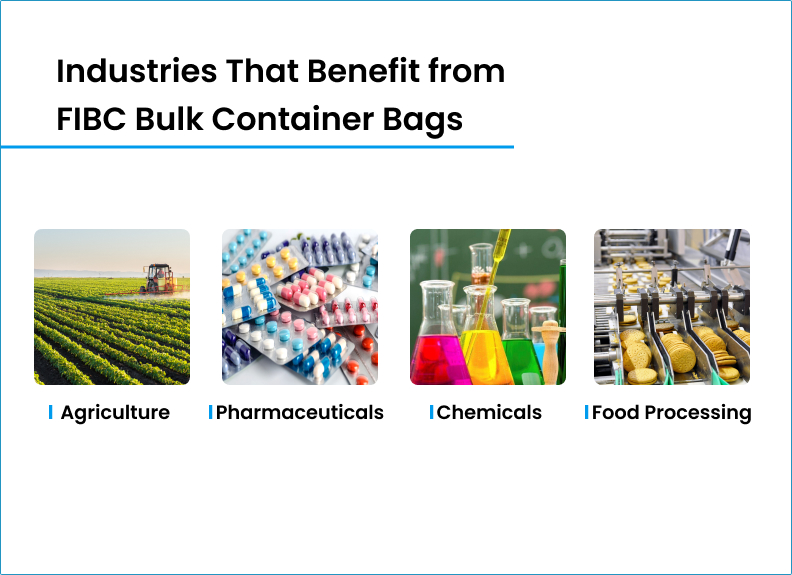
Agriculture
- Common uses: Grains, seeds, fertilizers, animal feed
- Importance: It protects from moisture and pests; ventilated or laminated bags extend shelf life
Pharmaceuticals
- Common uses: Powders, APIs, sensitive materials
- Importance: Cleanroom-grade bags with liners to avoid contamination; anti-static options provide safety
Chemicals
- Common uses: Risky or temperature-sensitive powders and granules
- Importance: Type C/D bags help to avoid static discharge; liners stop chemical reactions and high heat
Food Processing
- Common uses: Bulk dry ingredients like flour, sugar, salt, spices
- Importance: Food-grade liners maintain hygiene; moisture-proof and sift-proof seams preserve freshness
Choosing the Right FIBC Bags Manufacturer
How to Select a Reliable FIBC Jumbo Bag Manufacturer?
- You should focus on material quality to make sure they use high-grade polypropylene for good durability.
- Choose manufacturers that offer customization options for various industries.
- Choose a manufacturer that is capable of fulfilling your quantity needs without taking a long time.
- Choose one that offers quality at affordable prices without compromising on performance.
- Look for a manufacturer that offers eco-friendly FIBC options that support environmental standards.
- Choose one that is clear with communication and offers fast service as well as support after sales for easy working.
What Quality Standards Matter When Choosing a FIBC Bag Manufacturer
- ISO 9001: It confirms that the manufacturer follows strict quality control and production standards.
- FSSC 22000 / BRC Certification: It is necessary for the safe packaging of food items with hygiene and safety systems.
- UN Certification: It makes sure that bulk bags are safe and approved for the shipment of dangerous goods.
- ASTM Standards: It checks that bags follow the safety and durability rules used in global industries.
- REACH Compliance: It makes sure that bag materials follow EU rules for chemical safety and environmental protection.
Final Thoughts
Customization is necessary in today’s fast-paced logistics landscape. Using customized FIBC bulk bags, businesses can improve space and decrease costs in different industries. From agriculture to chemicals, the right bulk bag design can improve supply chain productivity.
If your bulk packaging still depends on general formats, now is the right time to analyze.
- Are your bags increasing load capacity and decreasing transport costs?
- Do they meet safety, legal, and eco-friendly needs?
- Are they designed to match your business goals and product requirements?
Analyzing your packaging can help you identify waste, highlight weak points, and help you choose smart bulk bag solutions.
Partner with Leading FIBC Bulk Bags Manufacturers
When you collaborate with certified, innovation-driven FIBC bulk bag manufacturers, they ensure:
- Access to
- Custom designs
- Liners
- Discharge options
- Compliance with
- ISO
- UN
- Food-grade standards
- Scalable production and reliable delivery worldwide
Choose partners that understand your industry and offer end-to-end support from design to delivery.
Source: https://dunnagesystems.com/custom-fibc-bags-why-tailoring-your-packaging-matters/


10 Expert Stall Design Tips to Boost the Exhibition Experience
Nowadays, your stall at the exhibition is more than a physical setup. Consider it as a strategic storytelling platform that highly focuses on the exhibition stall design.
From the moment visitors enter the stall, the entire setup becomes a visual ambassador for your brand. It represents your purpose and communication values.
A creative exhibition stall design grabs visitors’ attention and sparks conversations that help foster lasting immersion. Your design choices build a frame that the audience assumes and engages with your brand.
From layout and lighting to materials and messaging, every component is important in delivering an amazing user experience.
When done right, your exhibition stall design and fabrication convert potential visitors into meaningful brand interactions.
In this blog, you can go through 10 expert stall design tips to improve your exhibition stall‘s impact.
So let’s get started without any further ado!
10 Exhibition Stall Design Ideas to Elevate Your Brand Impact

1. Prioritize Flow and Function
With a successful exhibition stall design, visitors move around and engage without confusion.
- Create open walkaways for visitors that guide them through your stall and keep the space organized, as well as avoid the scenario of overcrowding.
- Keep your stall clean and simple to ensure your product and brand message grab attention and remain easy to navigate.
- Create clear entry and exit points that make visitors’ movement easy and decrease overcrowding areas.
- Use open spaces and nice, delicate dividers to highlight key points and encourage exploration without a harsh layout.
Easy stall flow provides visitors required comfort and increases interaction time, which helps with deeper engagement with your brand.
2. Use Multi-Sensory Elements
A creative exhibition stall design includes visuals (sound, lights, and touch) that engage visitors and deliver a memorable user experience.
- Play soft music to generate a welcoming atmosphere that helps you attract visitors without distracting from your exhibition setup.
- Highlight important areas and generate emotion by adding dynamic lighting like
- LED walls
- Spotlights
- Color-changing effects
- To invite hands-on exploration, add physical elements such as
- Textured surfaces
- Interactive touchscreens
- Product samples
- To encourage longer dwell time and deeper engagement, add immersive zones with layered sensory cues like
- Scent diffusers
- Motion-triggered visuals
- Soft materials
Multi-sensory design helps your exhibition stall deliver a memorable experience that engages visitors beyond visuals and static presentation.
3. Align Design with Brand Identity
Your exhibition stall should reflect your brand, not just with a display, but with a branded experience.
- Create instant recognition and build trust with your visitors by applying your brand colors and logo to all elements, like
- Signage
- Furniture
- Lighting
- Add props or furnishings that showcase your brand. For example, a clean energy brand might use
- Natural texture
- Recycled materials
- Green accents
- Reflect your brand voice and values through the exhibition stall with consistent messaging across
- Banners
- Screens
- Brochures
- Digital displays
4. Optimize Vertical Space
Using height creatively improves your exhibition stall design, especially when you have limited floor space.
- Hang banners and vertical screens for better visibility. They can be a brand signal and catch the attention of visitors from afar. Your visitors will be guided directly to your exhibition stall.
- Organize products at different heights with the use of tiered displays to save space and increase visibility. This layered approach highlights your important offerings without making your stall layout messy.
- Add tall signs or overhead boards to gain attention from afar. These visuals improve recognition and make your stall noticeable in crowded spaces.
Vertical design is not only about going up—it is about standing out.
5. Invest in Strategic Lighting
Lighting is one of the most powerful tools in exhibition stall design and fabrication. It makes a mood and grabs attention, which improves your brand presence.
- Use spotlight or accent lighting that grabs attention towards important areas like demos or displays to highlight your most important offerings.
- Adjust the color temperature with cool whites that create a modern vibe, and warm tones that make the environment cozy. The right lighting affects your users’ experience and helps them connect with your exhibition stall.
- To bring energy and movement to your stall and create a remarkable experience, use smart lighting controls like,
- Motion sensors
- Timed changes
- Ambient shifts
Strategic lighting is not only about the illumination; it also delivers amazing user experiences.
6. Incorporate Interactive Zones
Interactive zones in your exhibition stall invite visitors to engage and explore your offerings. It encourages them to share their experience with others.
- To build trust, set up demo counters where visitors can
- Test products
- Ask questions
- Experience your offerings firsthand
- Set up VR booths to involve visitors in your brand stories or product environments. Whether it is a virtual tour or a gamified experience, VR makes your exhibition stall design unforgettable.
- To generate curiosity and keep visitors engaged for long, use gamified displays like
- Digital quizzes
- Spin-to-win wheels
- Leaderboard challenges
- To encourage social media sharing and the stall’s reach beyond the event floor, design shareable moments with branded content like
- Photo booths
- AR filters
- Interactive art walls
Interactive zones not only grab attention, but they also offer amazing experiences that visitors will remember and talk about long after leaving your exhibition stall.
7. Design for Easy Setup and Transport
Smart exhibition stall design is a mixture of style with functionality. It makes setup, transport, and reuse easy for an amazing experience before and after the event.
- To save time and decrease labor costs, choose modular or portable structures that are
- Lightweight
- Collapsible
- Easy to assemble without tools
- Use magnetic backdrops and pre-fabricated panels for quick setup and easy branding. They are
- Reusable across events
- Save time
- Improve consistency
- Choose compact packaging and a carry case to make transport easy and keep stall components secured during traveling.
- Label and organize components clearly to increase the installation speed and avoid confusion on-site.
- To save cost and decrease waste, design your stall with reusability in mind. It helps with the reconstruction of the stall for different layouts.
When you keep your setup easy, you can have more time to focus on engaging visitors and decreasing stress behind the scenes.
8. Maximize Visual Storytelling
Effective exhibition stall design does not mean good looks. It includes telling an engaging story that connects with visitors and promotes your brand message.
- Represent your product benefits using clear graphics and infographics that simplify complicated features and highlight value. You should use
- Icons
- Diagrams
- Before-and-after visuals
- Create a layout that helps visitors move from a problem to your solution. Telling a story in this way creates emotional engagement and helps them understand your stall’s purpose.
- To maintain focus and avoid visual noise, use professional
- Clean lines
- Bold headlines
- Consistent branding
9. Add Hospitality Elements
A creative exhibition stall design with welcoming touches turns your stall into a comfort zone.
- To offer visitors a moment to rest and recharge, provide seating areas with
- Lounge chairs
- Bar stools
- Soft benches
- To create a friendly and relaxed atmosphere that encourages longer visits, offer refreshments like
- Water
- Coffee
- Branded snacks
- To show you care about visitor comfort and convenience, add device charging stations with easy-to-reach outlets or wireless pads.
- To make your stall a natural stop for visitors, design it as a “pause point” with calming
- Lighting
- Soft music
- Open space
- To reinforce your identity while offering comfort, use branded hospitality elements like
- Custom cups
- Napkins
- Signage
When visitors feel you care for them, there are high chances for their engagement and remember your brand.
10. Collaborate Closely with Fabricators
Successful exhibition stall design and fabrication require strong teamwork that includes aligning creative ideas with practical execution.
- Bring fabricators in early stages, which helps to turn your design ideas into real-life builds. They ensure your exhibition stall follows venue rules and budget, with a focus on quality and creativity.
- Plan your exhibition stall design according to the build timelines and safety rules. It helps to avoid costly delays/rework and ensure on-time delivery and compliance with
- Electrical
- Fire
- Structural standards
- To identify potential issues and ensure your stall looks and works as intended, perform mock-ups or simulations before the final build. It test
- Layout
- Lighting
- Branding components
- to keep everything aligned and on track, maintain open communication throughout the project, like
- Sharing updates
- Feedback
- Adjustments
Pro Insights on Exhibition Stall Design and Fabrication
Collaboration Between Designers and Fabricators
Creativity in exhibition stalls starts with strong collaboration between designers and fabricators.
- Fabricators should be involved during the concept phase to
- Analyze feasibility
- Suggest material choices
- Flag potential build challenges
- Designers work to bring vision, and fabricators work to bring proper execution. Regular coordination ensures creative elements ( floating panels or curved structures) are structured well and save cost.
- With mock-ups and prototyping, identify design flaws in the early stages and refine details before fabrication starts.
- Fabricators suggest practical changes that improve durability or make the setup easier. It makes your stall stronger and quicker to build.
Synced collaboration saves costly reworks and missed deadlines.
Fabrication Timelines and Structural Considerations
Smart exhibition stall design and fabrication depend on realistic timelines and strong structural planning for smooth execution.
- Timeline planning
- Design finalization takes 1–2 weeks based on complexity and revisions.
- Material procurement takes 3–5 days for standard components; longer for custom imports.
- The fabrication phase takes 1–3 weeks, based on
- Size
- Finishes
- Tech integrations
- Mock setup & testing takes 2–3 days to validate
- Fit
- Lighting
- Branding
- On-site installation takes 1–2 days before the event.
- Structural considerations
- Use collapsible frames and magnetic panels for quick setup and transport.
- Ensure heavy elements (like LED walls or counters) are added and balanced.
- Stick to
- fire-retardant materials
- Electrical safety codes
- Venue-specific load limits.
- Design open walkaways and low counters to serve different visitor needs.
Common Pitfalls to Avoid in Exhibition Stall Design
| Pitfall | Why It’s a Problem |
| Overloading the space with branding | Creates clutter, confuses messaging, and overwhelms visitors |
| Ignoring height and lighting | Wastes vertical space and reduces visibility in crowded environments |
| Minimal visitor interaction points | Limits engagement, weakens brand recall, and shortens visitor engagement time |
| Poor layout planning | Disrupts visitor flow and makes navigation awkward |
| Inconsistent branding | Spoil brand identity and reduce professional appeal |
| Neglecting comfort elements | Misses opportunities to build affinity through seating or hospitality |
| Overcomplicating the structure | Increases setup time and transport challenges |
Summing Up
A well-designed exhibition stall represents your brand from layout flow to interactive zones. Every detail in your exhibition stall design forms how visitors recognize and engage with your brand.
To highlight the exhibition floor, invest in a creative exhibition stall design that tells a story and offers hospitality features with an engaging structure. Collaborating with expert professionals ensures your vision is executed on time and on budget.
Strategic design not only makes things better, it changes everything.
Source: https://www.designlimelite.com/10-expert-stall-design-tips-to-boost-the-exhibition-experience/

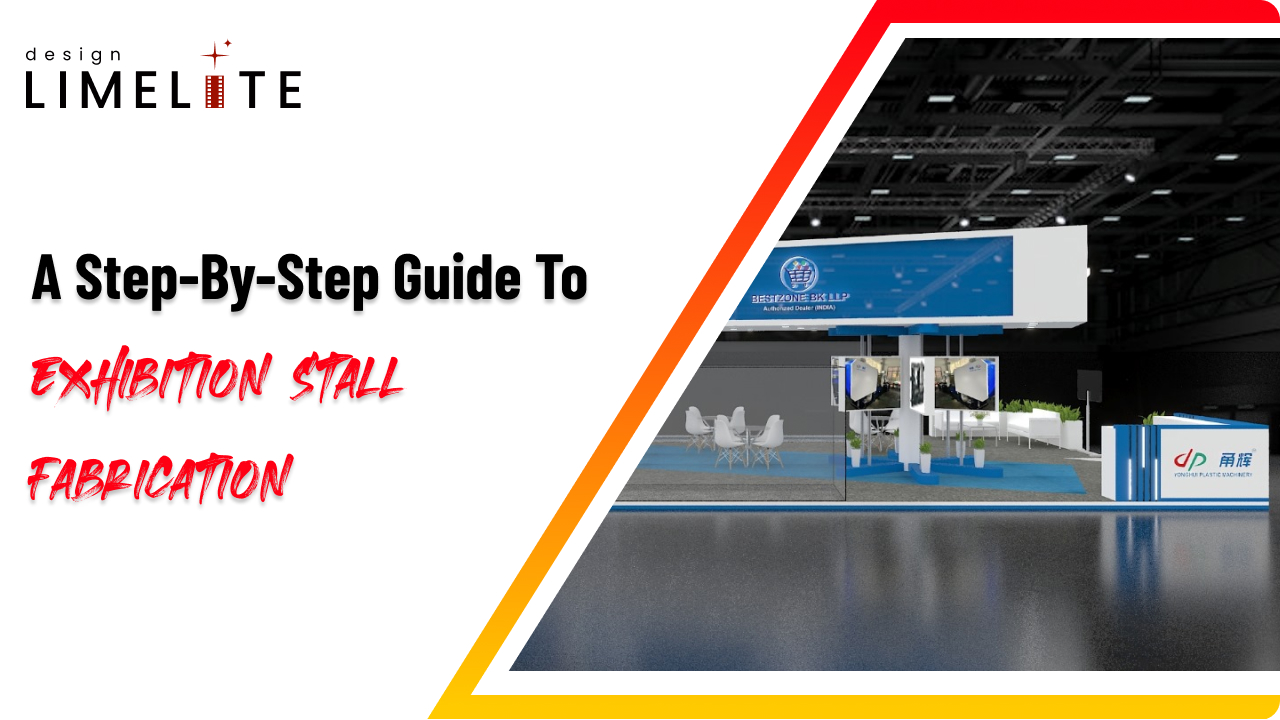
A Step-by-Step Guide to Exhibition Stall Fabrication
In the busy world of industrial expos and trade shows, the first impression is everything. Your exhibition stall is one of the touchpoints for potential clients and partners. That is when exhibition stall fabrication plays an important role.
Exhibition stall fabrication is a process of designing and constructing a branded booth that is customized for exhibitions and events. The process includes everything, from layout planning and material selection to structural build, lighting, and finishing. So, your booth looks both aesthetic and functional.
In a high-stakes environment, visibility can make or break opportunities. Therefore, investing in professional fabrication is important, as it is more than just a simple decoration now. You can transform your event presence into a strategic brand and grab attention as well as increase engagement.
If you want to showcase innovation and generate leads by launching new products, a well-designed stall can help you have lasting connections.
In this blog, you can go through an ultimate guide to designing and fabricating an exhibition stall. So let’s get started.
A Complete Step-by-Step Exhibition Stall Design and Fabrication Guide

Step 1: Define Objectives and Budget
Before starting stall designing make it clear what you want to achieve at the exhibition. It helps to make every decision.
What’s Your Goal?
Ask yourself these questions:
- Are you launching a product and want maximum visibility?
- Are you looking to generate brand awareness with eye-catching designs?
- Are you trying to create leads or connect with industry professionals?
- Do you want to deliver interactive demos or presentations?
When you know your purpose, you can prioritize design elements like,
- Layout flow
- Digital displays
- Engagement zones
Set a Realistic Budget
Once you are all set with your goals, you can outline a budget.
- Cover the costs for,
- Design
- Fabrication
- Logistics
- Rentals
- Staffing
- Decide on what is important vs. what is good to have
- LED walls vs. printed banners
- Modular structures vs. custom builds
- Consider the costs for,
- Branding materials
- Safety compliance
- On-site services
A clear budget with clear goals helps to avoid extra expenses and ensure a successful exhibition stall fabrication project.
Step 2: Conceptual Design
In this step, you can shape your stall’s personality before starting any physical work.
Build Around Your Brand
- You can make your stall easily recognizable by using your brand
- Colors
- Logo
- Fonts
- You can bring your brand story into visual elements such as,
- Panels
- Graphics
- Lighting
- You need to ensure consistency across
- Signage
- Digital displays
- Product zones
♀️ Focus on Visitor Experience
- You can design paths that feel natural and guide visitors in different sections.
- You need to place highlights (i.e., demo stations, product shelves) in high-impact zones.
- You can include resting or interaction points to boost engagement.
- You can keep the layout open, accessible, and welcoming.
️ Visual Planning Tools
- You can sketch or use 3D rendering software to preview various ideas.
- You should test
- The color combination
- Furniture placement
- Structural accents
- You can share mockups with stakeholders or fabricators to get feedback and refinements.
A thoughtfully designed exhibition stall can be a mixture of beauty and purpose. It attracts attention and delivers your brand message with high impact.
Step 3: Choose the Right Materials
Choosing the right materials is like selecting the bones and skin of your stall. It directly affects the look of your stall, the process of set up, and how long it lasts.
Lightweight Materials for Easy Setup
- If you want a quick installation, you should go for
- Aluminum frames
- PVC panels
- They are easy to transport, budget-friendly, and suitable for one-time use or short-term events.
- When you have limited setup time for an indoor exhibition, it is the best option to choose.
Durable Materials for Long-Term Use
- If you want materials for long-term use and need better support, you should go for
- Laminated MDF boards
- Steel structures
- They offer the best support and hold up well for different events. It also maintains a premium finish for a long time.
- These materials are suitable for brands that want to invest in a customized setup for longer use.
️ Consider the Environment
- If the venue is outdoors, it requires weather-resistant materials.
- Think about,
- Humidity
- Temperature
- Exposure to sunlight
- According to your needs, you can choose
- Waterproof coatings
- Anti-rust structures
- UV-resistant finishes
Choosing the right combination of materials ensures that your exhibition stall design and fabrication address your needs and goals.
️ Step 4: Fabrication Process – Bringing Your Stall to Life
After successful planning and design, it is now time to build your exhibition stall into real life. This step includes creating, installing, and finishing everything that helps your stall work smoothly.
Build the Structure
- Skilled teams start with
- Woodwork
- Metal framing
- Core construction
- You should focus on walls, counters, and different support elements that need to be shaped according to the final design.
- Check on signboards and branded features are carefully installed for better visibility.
Add Functional Components
- Install lighting systems to highlight important areas and generate an aura.
- Install audio-visual equipment like,
- Screens
- Speakers
- Digital displays
- To attract visitors, add interactive elements such as
- Touchscreens
- Demo zones
- Product shelves
Final Touch for Polish
- Add flooring, furniture, and branding graphics according to your theme.
- Check thoroughly to ensure everything is working and fits well.
- Clean and prepare the space for the event.
With expert support from an experienced exhibition stall fabrication team, your design reflects your brand and delights your client.
Tips for Effective Exhibition Stall Design and Fabrication

♂️ Optimize Space for Traffic Flow
- Create paths that guide visitors from the entrance to important areas, such as demonstrations or product displays.
- Maintain proper space and make it trouble-free, which helps visitors move easily.
- Use zoning to separate
- Demo areas
- Seating
- Product showcases
A layout that is organized properly is important for successful exhibition stall design and fabrication.
Use Visual Story Telling
- Deliver your brand message using
- Graphics
- Structure
- Lighting
- Show a clear narrative: problem → solution → benefit → action
- In your stall, you can add
- Digital screens
- Product visuals
- Live demonstration
When your stall design tells a story, it will create remarkable experiences for your potential clients.
Align Design with Branding
- In all your visuals, you can use your brand’s signature
- Colors
- Fonts
- Voice
- Place your logo and tagline where people can easily see them to highlight your brand.
- Add brand values into design themes such as,
- Sustainability
- Innovation
- Luxury
A visibly connecting look makes sure your exhibition stall design and fabrication build trust among your clients.
Common Mistakes to Avoid in Exhibition Stall Fabrication

When you avoid these common mistakes, your exhibition stall design and fabrication perform well and deliver a strong brand experience.
Overcomplicating the Design
- When you use too many elements, it can confuse your visitors and spoil your message.
- Your stall looks messy when you use many
- Signage
- Clashing colors
- Non-functional decor
You should keep the stall design clean and purposeful to showcase what is important.
♀️ Ignoring Visitor Interaction Zones
- You miss out on engagement if your stall lacks space for
- Demos
- Meetings
- Product exploration
- Without clear areas for communication, visitors may just pass by without stopping.
You should design interactive zones where visitors can touch, try, and learn about your offerings.
⏰ Last-Minute Fabrication Pitfalls
- Finishing the stall in a hurry can cause
- Poor finishing
- Layout issues
- Safety risks
- Delays can leave your stall unfinished and decrease the time you have to showcase it at the event.
You should coordinate with the fabrication team in advance and plan accordingly, as well as add buffer time.
Conclusion
Creating a successful exhibition stall needs thoughtful planning with smart design and a well-prepared execution in real life. Every step of the process is important to represent your brand on the exhibition floor.
When you plan well, exhibition stall fabrication turns your ideas into an appealing space. It captures attention and increases the chances of interaction with potential clients. You can easily convey your brand message to them.
To achieve a great result, it is important to work with experienced stall fabricators like Design LimeLite. They understand creative vision as well as the technical needs. With their expertise, you can make sure that everything works properly, starting from structural safety to branding components.
Source: https://www.designlimelite.com/a-step-by-step-guide-to-exhibition-stall-fabrication/

❓ Frequently Asked Questions (FAQs)
How long does exhibition stall fabrication take?
The timeline depends on the design complexity and customization.
- Standard stalls may take 7–10 days.
- Customization with advanced features may take 2–4 weeks.
- Delivery will be affected by factors like
- Material availability
- Approval cycles
- Last-minute changes
If you coordinate with your exhibition stall fabrication team earlier, it ensures an on-time installation.
What materials are best for stall construction?
The type of material depends on your budget, usage, and event type.
- Aluminium and PVC: They are lightweight and easy to install for short-term use.
- Laminated MDF and steel: They are long-lasting and visually premium for repeated setups.
- Fabric prints and modular panels: They are the best option for customized branding with portability.
When you choose the right materials, it ensures your exhibition stall design and fabrication stay visually appealing and structurally reliable.
Can stalls be reused across events?
Yes, if designed thoughtfully.
- Modular stalls with detachable panels are perfect for reuse.
- Reinforced structures hold up across multiple exhibitions.
- Choose neutral base designs that can be easily rebranded per event.
When you invest in reusable stalls, it decreases future expenses and increases productivity.
EcoVadis

EcoVadis
















GHG Accounting and Reporting











LinkedIn Content for QA Automation
LinkedIn Content for QA Automation
Week 1
Why QA Automation Is About More Than Speed
QA automation is often sold as a way to move faster. But speed isn’t the real value. What matters more is trust.
Automation helps teams catch issues early. It gives developers clear feedback. It keeps releasing stable versions. That’s what builds confidence, not just in the product, but in the process.
Microsoft’s approach shows this well. Their QA agents don’t just run tests. They
- Analyze failures
- Generate test data
- Help teams understand what went wrong
This leads to faster fixes and fewer surprises. You can see how it works here: Microsoft’s QA Testing Agent Scenario.
In Power Platform, Microsoft uses layered testing. They
- Start with critical functions
- Expand coverage gradually
It’s not about testing everything at once. It’s about testing what matters, when it matters. That’s how they keep updates reliable. Learn more here: Effective Automated Testing Strategies.
Automation also helps teams scale. When tests run consistently,
- Releases happen more often
- Teams stay in control
- Quality doesn’t slip
Automation helps reduce burnout. Manual testing takes time and feels repetitive. You run the same checks again and again, often under pressure.
With automation, teams get that time back. They can
- Focus on harder problems
- Fix bugs that affect users
- Improve how the product feels
That shift makes the work more meaningful. It also boosts morale and leads to better results.
And it’s not just about the team. Reliable automation builds trust with clients and users. It shows that
- Quality isn’t an afterthought
- Stakeholders can count on stability
- People stop worrying about what might break
QA automation isn’t a shortcut. It’s a safety net. It’s how you build a product that people can count on.
Here’s another example of how automation improves software quality at scale: Cigen’s QA Reliability Guide.
#QA #Automation #SoftwareTesting #Microsoft #TrustInTech #ReliabilityOverSpeed #PowerPlatform #QualityAssurance
Week 2
Automating Everything Is a Mistake
Automation helps. But automating everything? That’s a mistake.
Many teams chase full coverage, thinking more scripts mean better quality. In practice,
- It creates confusion and extra work
- It’s harder to spot what’s actually important
- It leads to brittle systems and wasted effort
Smart automation means choosing what to test and what to skip. You focus on what breaks often and what users depend on. And you target the parts that slow things down. The rest? You test manually or monitor in production.
Netflix doesn’t aim for 100% coverage. They focus on making systems strong. Their teams
- Simulate failures using chaos engineering
- Test how systems break and recover
- Prioritize resilience over perfection
Read more on Netflix’s Chaos Engineering Approach.
Google takes a similar approach. They
- Focus on high-risk, high-impact areas
- Avoid overloading pipelines with end-to-end tests
- Warn against false confidence from excessive automation
See their take here: Google’s Testing Blog.
Automating everything might feel thorough, but it often backfires. Tests break for the wrong reasons. Teams waste time fixing broken tests instead of making the product better. And when automation becomes a checkbox, it loses its value.
Here’s the real issue: full automation creates a false sense of safety. Just because something is tested doesn’t mean it’s tested well.
- Coverage maps show quantity, not quality
- Quantity alone doesn’t protect your users
Instead, build a strategy:
- Know your weak spots
- Automate where it adds confidence
- Leave space for human judgment
- Use exploratory testing to catch real-world bugs
Good automation supports your team. It doesn’t overwhelm them. It doesn’t replace thinking. It helps people focus on what matters.
Reliable automation also improves morale. When tests are useful, people trust them. When scripts are noisy, people ignore them. That’s when risk creeps in.
Here’s a practical guide to doing it right: Thoughtworks on Strategic Test Automation.
Automation should be a tool, not a trap. Use it wisely.
#QA #Automation #SoftwareTesting #Netflix #Google #TestStrategy #SmartAutomation #QualityOverCoverage #TechLeadership #EngineeringExcellence
Week 3
Flaky Tests Kill Confidence
Flaky tests are more than a nuisance; they’re a trust killer.
When tests fail randomly, teams stop believing in the results. They
- Ignore failures
- Rerun pipelines without fixing the root cause
- Hope for the best instead of relying on the system
That’s not resilience. That’s roulette.
Shopify faced this head-on. Their CI pipelines were clogged with unreliable tests. Developers couldn’t tell if failures were real or just noise. It
- Slowed down releases
- Drained team morale
- Undermined confidence in automation
Instead of chasing full coverage, they focused on stability. You can read their story here: Shopify’s CI Pipeline Optimization Story
Flaky tests break the feedback loop. They waste time, erode confidence, and make teams question the value of automation. And when trust fades, so does discipline. People skip checks. Bugs slip through. Quality drops.
So what can you do?
Start with retries, but use them wisely. Shopify added retry logic to
- Separate real failures from random ones
- Reduce noise in the pipeline
- Improve signal clarity
They also built dashboards to track flakiness over time. That visibility changed everything. Teams could spot patterns, prioritize fixes, and hold each other accountable. Learn more about the approach here: Flaky Test Detection and Prevention Guide
Another fix: quarantine unstable tests. Don’t let one flaky script block the whole pipeline. Flag it, isolate it, and fix it without slowing everyone down. This keeps the pipeline clean and the team focused.
Also, invest in test ownership. Every test should have a clear owner. If it fails, someone’s responsible. That accountability keeps quality high and flakiness low.
Flaky tests won’t go away on their own. You need
- A plan
- Visibility
- A mindset that treats test stability like a product feature, not an afterthought
Pipeline resilience isn’t just about speed. It’s about trust. And trust starts with reliable tests.
#QA #Automation #CI_CD #Shopify #SoftwareTesting #PipelineResilience #FlakyTests #TestStrategy #EngineeringExcellence #DevOps
Week 4
AI Is Making Regression Smarter
Regression testing used to be a slow, repetitive task. Every change meant rerunning hundreds of scripts—just to make sure nothing broke. It was safe, but not smart.
Now AI is changing that. It’s not replacing QA teams. It’s helping them work faster and focus on what matters.
One shift is predictive testing. Instead of running every test, AI looks at code changes and past bugs to guess where problems might show up. That means
- Fewer tests
- Faster feedback
- Smarter coverage
GenQE explains how AI can rank tests by risk and relevance—like focusing on login flows after an update to authentication.
Another change is adaptive scripts. Traditional tests break when the UI changes. AI can fix that. It
- Spot layout shifts, or renamed buttons
- Updates scripts automatically
- Keeps pipelines stable with less maintenance
This self-healing feature saves time and keeps pipelines stable. LambdaTest shows how AI tools now write and repair scripts using plain language.
AI also helps teams spot patterns. It learns from past test runs, logs, and user behavior. It flags flaky tests, predicts failures, and suggests what to fix. That kind of insight used to take hours. Now it’s built into the workflow.
But AI doesn’t replace human judgment. It doesn’t handle edge cases or usability. It just:
- Clears the noise
- Highlights what matters
- Supports deeper testing
Katalon’s research shows how AI-powered regression tools improve speed, reduce errors, and expand coverage. Their TrueTest platform is built to bring this into everyday QA.
The future of QA isn’t about running more tests. It’s about running the right ones. AI helps teams:
- Test less but learn more
- Turn regression into a smart safety net
- Build confidence without slowing down
And that’s what better testing looks like.
#QA #RegressionTesting #AIinTesting #Automation #PredictiveTesting #AdaptiveScripts #LambdaTest #GenQE #Katalon #SoftwareQuality #FutureOfQA #EngineeringExcellence
LinkedIn Content for Career Coaching and Immigration
Part 1: Is your profile U.S.-ready? (Signs 1–3)
So you’re thinking about making your mark in the U.S.? Cool—let’s skip the pep talk. Here’s what actually matters. Check these signs and see where you stand:
- GLOBAL SWAGGER: HAVE YOU GONE BEYOND YOUR BACKYARD?
Built something that people across countries use? Is your work talked about outside your home turf? If it’s still stuck in your local WhatsApp group… you’ve got work to do.
- LEADERSHIP: DID YOUR WORK ACTUALLY MAKE A DIFFERENCE?
Did you just sit in meetings, or did you actually change things? Led teams? Changed how things work? Shook up the system for real results? Titles mean nothing. Impact is everything.
- YOUR RECEIPTS: CAN YOU PROVE YOUR IMPACT?
Got legit awards, media mentions, patents, or public wins? If it’s not verifiable, it doesn’t count. Stack up the proof.
If you’re missing one or two, that’s normal. Most people are. Building a U.S.-ready profile takes intention.
#CareerCoaching #USImmigration #EB1A #O1Visa #GlobalTalent #ExecutiveHiring #StartupFounders #Researchers
Part 2: Is your profile U.S.-ready? (Signs 4–5 + CTA)
Let’s keep going. Here are two more signs your profile is ready for the U.S. market:
- ONLINE PRESENCE: DOES IT ACTUALLY ADD UP?
LinkedIn matches your resume—it’s not like two different people. Both are clear and easy to understand. People should know what you do and why it matters.
- CAREER STORY: DOES IT MAKE SENSE FOR THE U.S.?
No weird gaps. No made-up titles. Your experience fits the U.S. vibe—real, relevant, and easy to follow.
Still unsure? Everyone misses a few of these. That’s why strategy matters.
Want a quick checklist to see how you stack up? Message me or drop a comment. I’ll send it over—no fluff, just facts.
#LinkedInTips #CareerStrategy #USImmigration #EB1A #O1Visa #Researchers #StartupFounders #Fortune500
1 Brochure_Accounting AccRuvia
1 Brochure_Accounting AccRuvia









Blog Categories
- BLOCKCHAIN USECASES (11)
- BLOGS (178)
- Brochure Content (2)
- GUEST POSTS (42)
- Linkedin Posts (4)
- NEWS (19)
- PRESS RELEASE (10)
- Web Pages (6)
I'D LOVE TO HEAR FROM YOU
INTERESTED IN WORKING TOGETHER ?
Khushaly Bhatt
I am available for freelance content writing work. You can checkout my Resume. Please reach out to me with your project details, I’ll get back to you shortly.
- content@khushalybhatt.in
- @khushaly_bhatt
- @Linkedin Profile
- Bhavnagar, Gujarat
- Working Hours: Mon-Sat (9AM to 7PM)
Copyright@ 2025 – Khushaly Bhatt – HOME | WHAT I DO | RESUME | TESTIMONIALS | BLOGS


















